Microsoft System Center Service Manager - Part 2: Installation
In this article, I will show you how to install the basic Service Desk services as well as the data warehouse components of this product.
Microsoft continually improves its System Center product line to enable IT organizations to simplify product purchases, serving their management and service needs. The latest entry for the System Center line is Service Desk and in this section we will introduce how to install the basic Service Desk services as well as the product warehouse data components.
Install Service Manager Management Server
As always with a new software, you need to start the process by inserting the installation DVD or using Service Manager ISO on the new server. Then navigate to the AMD-64 folder and double-setup setup.exe. Now the installation process will start and you will see the screen shown in Figure 1 below. From this screen, select the option Install a Service Manager management server .
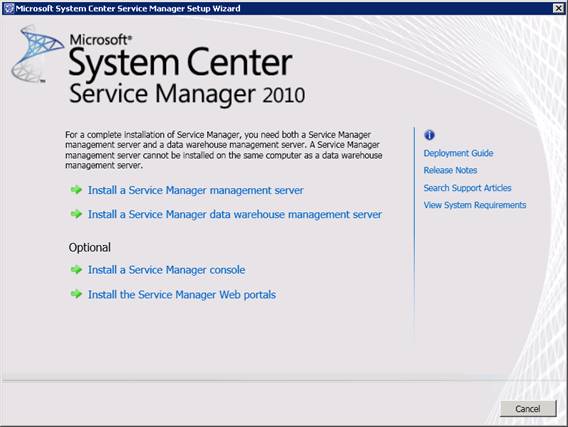 Microsoft System Center Service Manager - Part 2: Installation Picture 1
Microsoft System Center Service Manager - Part 2: Installation Picture 1
Figure 1: Service Manager installation window
The second step in the installation process is to provide your name and organization name and product registration agreement. Click the Next button to continue the process. Figure 2 shows you this window.
 Microsoft System Center Service Manager - Part 2: Installation Picture 2
Microsoft System Center Service Manager - Part 2: Installation Picture 2
Figure 2: Agreement on Service Manager registration
The default installation location for Service Manager is C: Program FilesMicrosoft System CenterService Manager 2010. If you prefer to select another location, click the Browse button and browse to the location where you prefer to install Service Manager. The installation location window is shown in Figure 3. Click Next to continue the process.
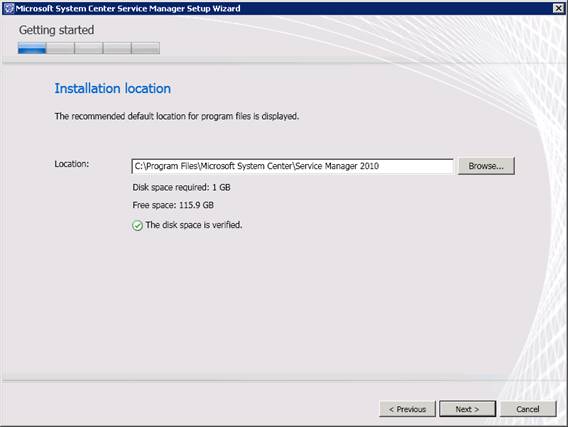 Microsoft System Center Service Manager - Part 2: Installation Picture 3
Microsoft System Center Service Manager - Part 2: Installation Picture 3
Figure 3: Select where to install Service Manager
Here, the installation tool will verify that your server has all the necessary requirements. The installer will check the amount of RAM in the system, processor speed and check whether the two conditions need to be installed. If one of the two conditions is missing, the download link will appear in the system test results window. As you can see in Figure 4, our lab system only has 1GB of RAM, while Microsoft recommends having a minimum of 4GB.
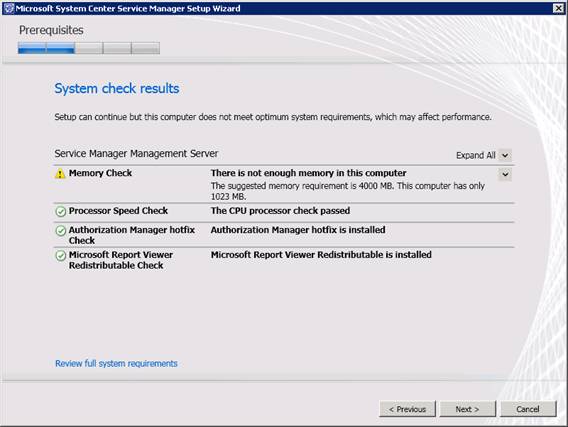 Microsoft System Center Service Manager - Part 2: Installation Picture 4
Microsoft System Center Service Manager - Part 2: Installation Picture 4
Figure 4: Service Manager system test results
The actual work begins on the next page of the installation wizard, where you will be asked to provide information about the Service Manager database. The main requirement here is to specify the database server name to configure the Service Manager database. If you are using SQL Server instance, the instance is not supported by Service Manager, then the instance will not be listed for use. When providing the database server name, other details include the database name, the size and the original database data, and the locations where the log file will be stored automatically. However, you can change these options. In Figure 5, you will see we selected the default options for our Service Manager installation.
 Microsoft System Center Service Manager - Part 2: Installation Picture 5
Microsoft System Center Service Manager - Part 2: Installation Picture 5
Figure 5: Configuring the service management database
Like other System Center products, such as Operations Manager, Service Manager creates a management group to present a number of different aspects of the company - name, unit, department, location or whatever what you like We created our management team with the HQ name. In addition, you need to set the name of the Active Directory group to which user accounts are allowed to manage this group. In Part 1 of the series, we created the Active Directory group called SM-admins and assigned it some user accounts. Specify that Active Directory group name on the configuration page in Figure 6.
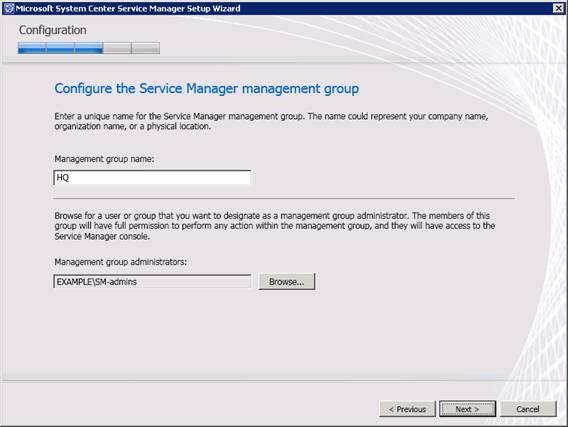 Microsoft System Center Service Manager - Part 2: Installation Picture 6
Microsoft System Center Service Manager - Part 2: Installation Picture 6
Figure 6: Configuring the initial management group
Service Manager services can operate under the context of a Local System account or under a domain account. For security reasons, domain account usage is preferred. During the installation process, you can click the Test Account button to make sure that the certificates are properly configured. In Figure 7, you will see the account provided is not a member of the administrative group on the local computer. When that account is added to the local admin group - Figure 8 - the certificates will be accepted as valid.
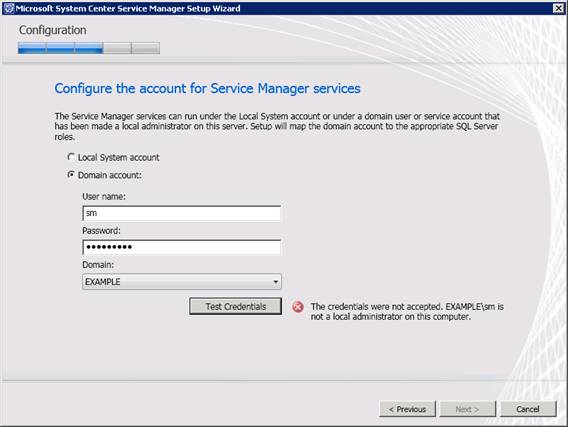 Microsoft System Center Service Manager - Part 2: Installation Picture 7
Microsoft System Center Service Manager - Part 2: Installation Picture 7
Figure 7: The account has not been properly configured
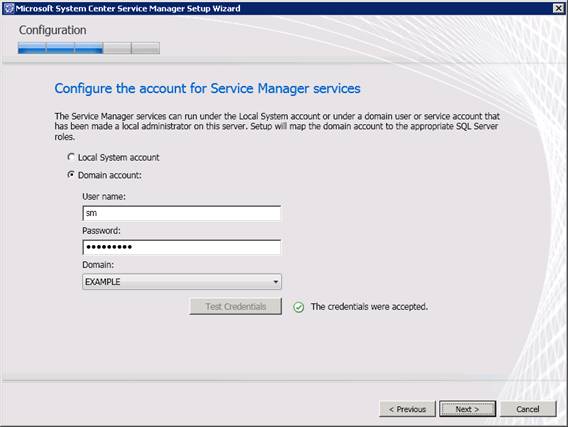 Microsoft System Center Service Manager - Part 2: Installation Picture 8
Microsoft System Center Service Manager - Part 2: Installation Picture 8
Figure 8: The account is properly configured
Service Manager routes information by using workflows running under a separate service account. For the basic Service Manager service account, it can be either Local System or domain service account. In Figure 9, you will see that we are using the same domain account for both Service Manager and Service Manager's workflow service.
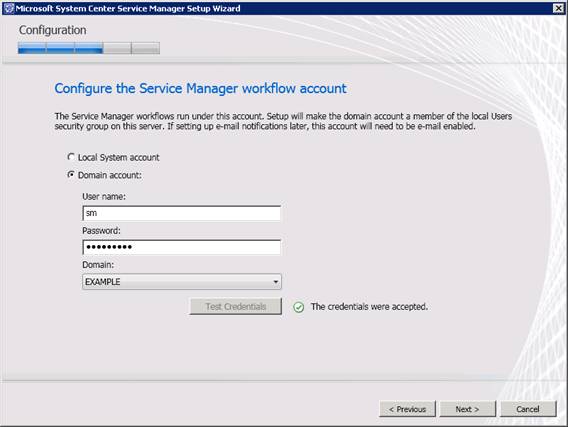 Microsoft System Center Service Manager - Part 2: Installation Picture 9
Microsoft System Center Service Manager - Part 2: Installation Picture 9
Figure 9: Service Manager account
For many products, Microsoft often collects information during its use to help the company release patches later. If you like to participate in the customer experience improvement program, select Yes and click Next .
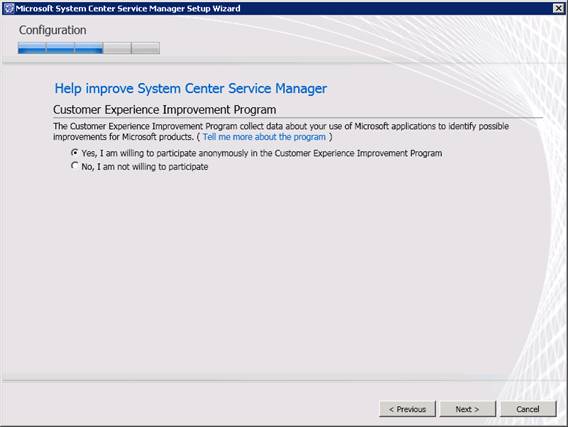 Microsoft System Center Service Manager - Part 2: Installation Picture 10
Microsoft System Center Service Manager - Part 2: Installation Picture 10
Figure 10: Attend the Customer Experience Improvement Program
Software upgrades have a protective effect on installation by providing patches over time. Some administrators prefer to do all the upgrades themselves to be able to test them in a lab environment before deploying, while some other administrators want updates to be installed as quickly as possible. . If you want the updates to be installed quickly and automatically, select the Use Microsoft Update option in the next screen of this wizard. Otherwise, select the option I do not want to use Microsoft Updates .
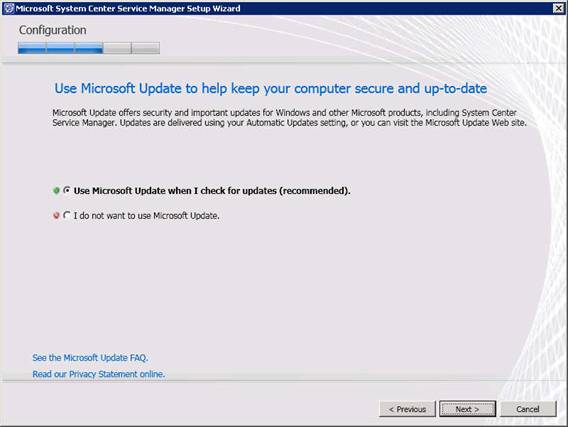 Microsoft System Center Service Manager - Part 2: Installation Picture 11
Microsoft System Center Service Manager - Part 2: Installation Picture 11
Figure 11: Decide how to handle software upgrades
Here, you will see the options selected. On the installation summary page, click Install to perform the installation.
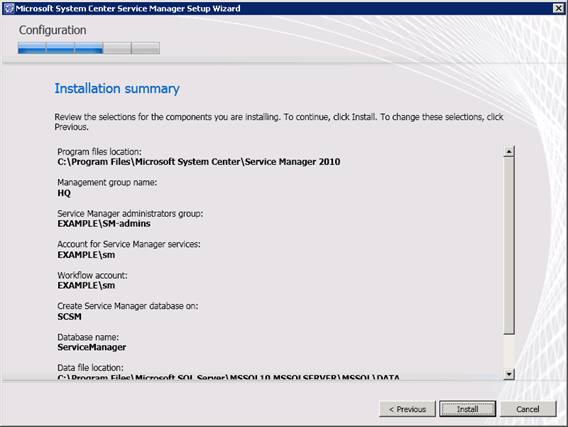 Microsoft System Center Service Manager - Part 2: Installation Picture 12
Microsoft System Center Service Manager - Part 2: Installation Picture 12
Figure 12: Service Manager installation summary
When the installation process is finished, you will see a screen similar to the one shown in Figure 13.
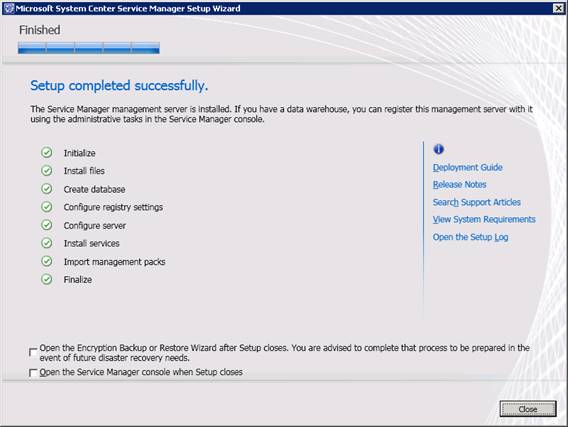 Microsoft System Center Service Manager - Part 2: Installation Picture 13
Microsoft System Center Service Manager - Part 2: Installation Picture 13
Figure 13: Service Manager has been installed
Install Data Warehouse Management Server
After installing the Service Manager Management Server, you can switch to installing Data Management Management Server (Data warehouse management server) to manage Service Manager data components. These components complement System Manager data reporting capabilities as well as provide an analysis of what's going on in your environment.
To perform the installation of the data warehouse component, navigate back to the installation location and double-setup setup.exe. In the launch page, click Install a Service Manager data warehouse management server . If it is a new installation, review image 1.
Because there are so many data warehouse settings that are similar to the basic Service Manager installation, what is the same will not be repeated, but we only introduce the different points.
Before starting the installation, there is an important configuration step that you must take if you decide to use another SQL server for the data warehouse component and reporting service. You must make some changes to the configuration for SQL Server Reporting Services to allow it to work with Service Manager. Microsoft provides very specific instructions for this step here.
The first screen of the installation wizard is the data warehouse configuration screen. In Figure 14, you will see up to three default databases created during the installation process:
- DWstagingAndConfig
- DWRepository
- DWDataMart
As with the main Service Manager product, the data warehouse database should also be configured. During the installation process, you will see a window similar to the one shown in Figure 14. Unless you are in a very large infrastructure, you can use the same service-configured database server. Manager. You can also choose other options for other Service Manager databases if you wish. You can also name databases if you like and choose where to store database files.
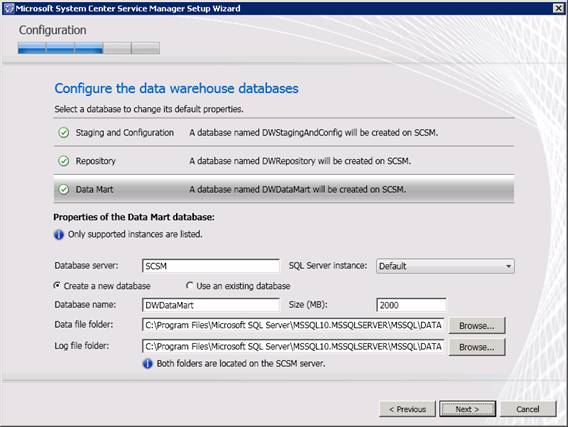 Microsoft System Center Service Manager - Part 2: Installation Picture 14
Microsoft System Center Service Manager - Part 2: Installation Picture 14
Figure 14: Data warehouse default installation options
Remember that you had to create a Service Manager management group during the installation process. With the data warehouse component, you also need to create a management team, but this time is for the data warehouse component. In Figure 15, you will see that I have used the DW_EXAMPLE name for this series. We also use the name SM-admins used for Service Manager installation.
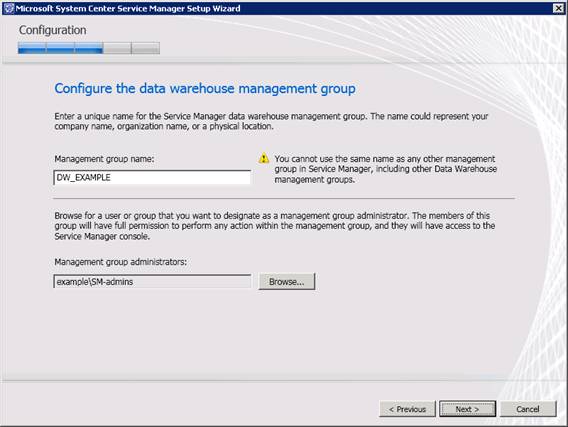 Microsoft System Center Service Manager - Part 2: Installation Picture 15
Microsoft System Center Service Manager - Part 2: Installation Picture 15
Figure 15: Data warehouse management team
During the installation of SQL Server, you probably did not install a complete configuration set of SQL Server Reporting Services (SSRS). Meanwhile SSRS is heavily used by Service Manager's data warehouse component. In Figure 17, you can see that we are using a server named SCSM for the different Service Manager databases as well as for the Service Manager reporting component.
 Microsoft System Center Service Manager - Part 2: Installation Picture 16
Microsoft System Center Service Manager - Part 2: Installation Picture 16
Figure 16: Reporting service information
For reporting, Service Manager uses the domain account that you configure to create reports and read data warehouse data sources. For simplicity, we use the account named sm here.
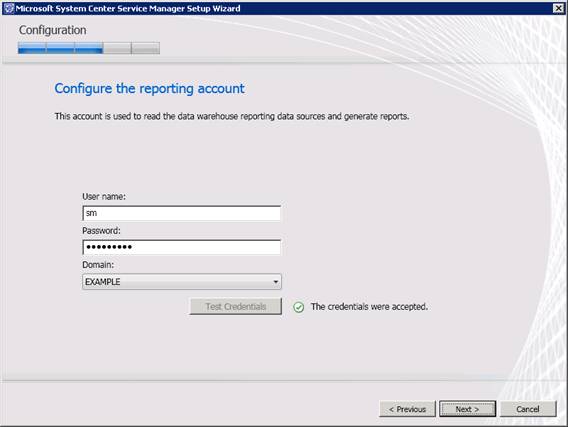 Microsoft System Center Service Manager - Part 2: Installation Picture 17
Microsoft System Center Service Manager - Part 2: Installation Picture 17
Figure 17: Account report
When running through different configuration items, the data warehouse installer will provide you with a summary table for you to review. Once you have made your choices, click the Install button to proceed with the installation.
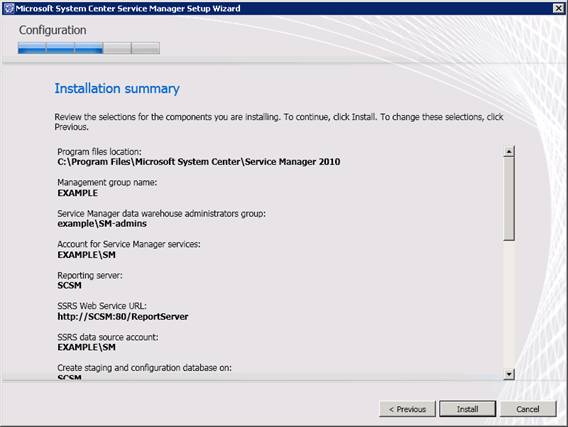 Microsoft System Center Service Manager - Part 2: Installation Picture 18
Microsoft System Center Service Manager - Part 2: Installation Picture 18
Figure 18: Summary of Data warehouse installation process
You should read it
- Microsoft System Center Service Manager - Part 1: Introduction and planning
- Microsoft System Center Service Manager - Part 4: Use
- Microsoft System Center Service Manager - Part 3: Initial configuration
- Theory - What is Active Directory?
- Check Exchange 2007 with System Center Operations Manager 2007 - Part 3
- Check Exchange 2007 using System Center Operations Manager 2007 - Part 1
- Fix Service Host Local System status using multiple CPUs in Windows 10
- Restore deleted components in Active Directory
- Configure the Lightweight Directory Service service - Part 3
- Configure the Lightweight Directory Service service - Part 4
- Configuring the Lightweight Directory Service service - Part 1
- Check Exchange 2007 with System Center Operations Manager 2007 - Part 2
May be interested

Microsoft System Center Service Manager - Part 3: Initial configuration

Back up virtual machines with Windows Server 2008 R2 and Hyper-V

Collect the Process ID information or GUID of Hyper-V Virtual Machine

Strategy for checking Failover Cluster - Part 2

Microsoft System Center Service Manager - Part 4: Use

Learn about Microsoft Network Monitor tool - part 1






 Microsoft System Center Service Manager - Part 3: Initial configuration
Microsoft System Center Service Manager - Part 3: Initial configuration Microsoft System Center Service Manager - Part 4: Use
Microsoft System Center Service Manager - Part 4: Use Microsoft System Center Service Manager - Part 1: Introduction and planning
Microsoft System Center Service Manager - Part 1: Introduction and planning Check Exchange 2007 with System Center Operations Manager 2007 - Part 3
Check Exchange 2007 with System Center Operations Manager 2007 - Part 3 Check Exchange 2007 using System Center Operations Manager 2007 - Part 1
Check Exchange 2007 using System Center Operations Manager 2007 - Part 1 Check Exchange 2007 with System Center Operations Manager 2007 - Part 2
Check Exchange 2007 with System Center Operations Manager 2007 - Part 2